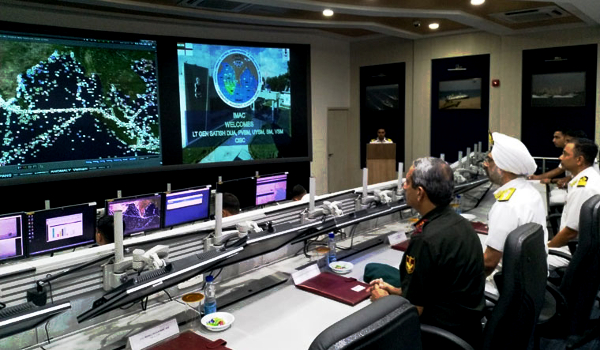In line with Prime Minister Narendra Modi’s vision towards Security and Growth of all in the Region (SAGAR, the Indian Navy’s Information Fusion Centre (IFC) for the Indian Ocean Region (IOR) will be inaugurated by the defence Minister Nirmala Sitharaman on Thursday.
In line with Prime Minister Narendra Modi’s vision towards Security and Growth of all in the Region (SAGAR, the Indian Navy’s Information Fusion Centre (IFC) for the Indian Ocean Region (IOR) will be inaugurated by the defence Minister Nirmala Sitharaman on Thursday. The virtual launch of the IFC-IOR centre is a beginning of a new era wherein collaborative, inclusive and high tech approach would be adopted to detect and deter maritime security threats of the region.
It will enable Indian Navy to interact with various multinational constructs and international and national agencies for information on White Shipping.
Speaking to Financial Express Online on condition of anonymity, a senior officer said that “The collated data will comprehensively improve the situational awareness on merchant shipping in the IOR. The aim is to facilitate dissemination of analysed maritime security and safety information to partner nations, constructs and agencies.”
The IFC has been established at Gurugram and collocated with Information Management and Analysis Centre (IMAC) which is jointly run by the Indian Navy and Indian Coast Guard and is the single point centre linking all the coastal radar chains to generate a seamless real-time picture of the nearly 7,500-km coastline.
The IOR accounts for 66% of world’s oil, 33 percent of bulk cargo and 50 percent of container shipments with over 100,000 ships transiting through it annually. With over 75% of the world’s maritime trade and 50% of daily global oil consumption passing through the region; IOR is vital to world trade and the economic prosperity of many nations.
The IOR is also a fragile environment, with threats such as maritime terrorism, piracy, human and contraband trafficking, illegal and unregulated fishing, arms running and poaching being prevalent. Hence, facilitating a conducive Environment to undertake legitimate maritime activities in this region is a necessity.
Explaining the need for setting up such a Centre, the officer said that, “Situational awareness in the IOR is important for the well-being of many countries. However, considering the large quantum of merchant shipping transiting the IOR and the multi-national nature of world maritime trade, it is not possible for any single nation to individually monitor the oceans, which thus necessitates collaborative arrangements between countries. These include bilateral information sharing agreements.”
Most of the countries which have inked the white shipping information exchange agreements with India, around 21 are IFC partners. The Indian Navy is mandated to conclude White Shipping Information Exchange agreements with 36 countries and three multi-national constructs.
The Indian Navy Chief Admiral Sunil Lanba had told the media earlier this month that “To date, these have been signed with 19 countries and one multi-national construct and data exchange is already in progress with 12 countries.”
The member countries of the IFC will have an option of positioning liaison officers, for which there is a major requirement of building up the infrastructure.
As has been reported earlier by FE Online recently, ‘White Shipping’ information refers to the information on merchant shipping. This information is available primarily through the Automatic Identification System (AIS), which are equipment fitted on merchantmen with more than 300 Gross Registered Tonnage as mandated by the International Maritime Organisation.
The AIS information from ships comprises name, MMSI number, position, course, speed, last port visited, destination etc. This information can be picked up through various AIS sensors including coastal AIS chains, satellite based AIS receivers and V/ UHF AIS receivers. Merchant ships whose AIS transmissions are not available are colloquially called ‘Dark Shipping’.
Establishment of the IFR-IRO would ensure that the entire region is benefited by mutual collaboration and exchange of information and understanding the concerns and threats which are prevalent in the region.
Source:FE
Image Courtesy:TW
You may also like
-
IAF Aircraft Set Course For Exercise Eastern Bridge VII At Oman
-
IAF Set To Host The Indian Defence Aviation Exposition-II At Jodhpur
-
Defence Secretary to co-chair 5th India-Philippines Joint Defence Cooperation Committee meeting in Manila
-
Simultaneous Launch Of ‘malpe And Mulki’, Fourth And Fifth Ships Of Asw Swc (Csl) Project
-
Aatmanirbharta in Defence: MoD signs Contract with HAL for 240 AL-31FP Aero Engines for Su-30MKI Aircraft
